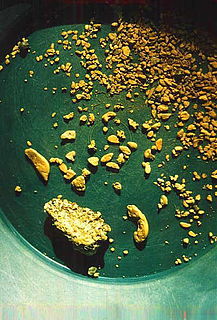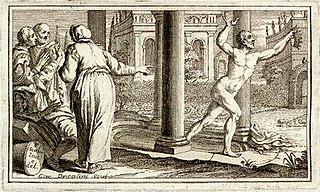Related Research Articles

John Augustus Sutter, born Johann August Sutter and known in Spanish as Don Juan Sutter, was a German-born Swiss immigrant of Mexican and American citizenship, known for establishing Sutter's Fort in the area that would eventually become Sacramento, California, the state's capital. Although he became famous following the discovery of gold by his employee James W. Marshall and the mill-making team at Sutter's Mill, Sutter saw his own business ventures fail during the California Gold Rush. Those of his elder son, John Augustus Sutter Jr., were more successful.

The California Gold Rush (1848–1855) was a gold rush that began on January 24, 1848, when gold was found by James W. Marshall at Sutter's Mill in Coloma, California. The news of gold brought approximately 300,000 people to California from the rest of the United States and abroad. The sudden influx of gold into the money supply reinvigorated the American economy, and the sudden population increase allowed California to go rapidly to statehood, in the Compromise of 1850. The Gold Rush had severe effects on Native Californians and accelerated the Native American population's decline from disease, starvation and the California Genocide. By the time it ended, California had gone from a thinly populated ex-Mexican territory, to having one of its first two U.S. Senators, John C. Frémont, selected to be the first presidential nominee for the new Republican Party, in 1856.

Nevada County is a county in the Sierra Nevada of the U.S. state of California. As of the 2010 census, the population was 98,764. The county seat is Nevada City. Nevada County comprises the Truckee-Grass Valley, CA Micropolitan Statistical Area, which is also included in the Sacramento-Roseville, CA Combined Statistical Area, part of the Mother Lode Country.

Gold, also called golden, is a color.

Placer mining is the mining of stream bed (alluvial) deposits for minerals. This may be done by open-pit or by various surface excavating equipment or tunneling equipment.

The Spanish dollar, also known as the piece of eight, is a silver coin of approximately 38 mm (1.5 in) diameter worth eight Spanish reales. It was minted in the Spanish Empire following a monetary reform in 1497. It was widely used as the first international currency because of its uniformity in standard and milling characteristics. Some countries countersigned the Spanish dollar so it could be used as their local currency.

A gold nugget is a naturally occurring piece of native gold. Watercourses often concentrate nuggets and finer gold in placers. Nuggets are recovered by placer mining, but they are also found in residual deposits where the gold-bearing veins or lodes are weathered. Nuggets are also found in the tailings piles of previous mining operations, especially those left by gold mining dredges.

The Panama–Pacific International Exposition was a world's fair held in San Francisco, California, United States, from February 20 to December 4, 1915. Its stated purpose was to celebrate the completion of the Panama Canal, but it was widely seen in the city as an opportunity to showcase its recovery from the 1906 earthquake. The fair was constructed on a 636 acre(1 sq. mi., 2.6 km2) site along the northern shore, between the Presidio and Fort Mason, now known as the Marina District.

The Palace of Fine Arts in the Marina District of San Francisco, California is a monumental structure originally constructed for the 1915 Panama-Pacific Exposition in order to exhibit works of art. Completely rebuilt from 1964 to 1974, it is one of only a few surviving structures from the Exposition.
Gold is a chemical element with symbol Au and atomic number 79.

The Folsom Lake State Recreation Area surrounds Folsom Lake in the foothills of the Sierra Nevada, and is managed by the California Department of Parks and Recreation. It is located near the city of Folsom, California, about 25 miles (40 km) east of Sacramento.
The fineness of a precious metal object represents the weight of fine metal therein, in proportion to the total weight which includes alloying base metals and any impurities. Alloy metals are added to increase hardness and durability of coins and jewelry, alter colors, decrease the cost per weight, or avoid the cost of high-purity refinement. For example, copper is added to the precious metal silver to make a more durable alloy for use in coins, housewares and jewelry. Coin silver, which was used for making silver coins in the past, contains 90% silver and 10% copper, by mass. Sterling silver contains 92.5% silver and 7.5% of other metals, usually copper, by mass.

Eureka is an interjection used to celebrate a discovery or invention. It is a transliteration of an exclamation attributed to Ancient Greek mathematician and inventor Archimedes.

The quarter eagle was a gold coin issued by the United States with a denomination of two hundred and fifty cents, or two dollars and fifty cents. It was given its name in the Coinage Act of 1792, as a derivation from the US ten-dollar eagle coin. Its purchasing power in 1800 would be equivalent to $71.12 in 2015 dollars.

The California Midwinter International Exposition of 1894, commonly referred to as the "Midwinter Exposition" or the "Midwinter Fair", was a World's Fair that officially operated from January 27 to July 5 in San Francisco's Golden Gate Park.

Southwest Museum is an at-grade light rail station in the Los Angeles County Metro Rail system. It is located near the intersection of Marmion Way at Museum Drive in the Mount Washington neighborhood of Northeast Los Angeles, California. The station is served by the Gold Line.

Highland Park is an at-grade light rail station in the Los Angeles County Metro Rail system. It is located near the intersection of North Avenue 57 at Marmion Way in the Highland Park neighborhood of Northeast Los Angeles, California. The station is served by the Gold Line. It is the first station on the line going west towards Atlantic station that's in the city of Los Angeles city limits.
Potholes is a former gold camp and settlement in Imperial County, California. The settlement was located on the railroad line 4 miles (6.4 km) northeast of Bard along the Colorado River near the site of the Laguna Dam.

Fine Gold is an unincorporated community in Madera County, California. It is located 6.5 miles (10 km) west-southwest of North Fork, at an elevation of 1352 feet.

A gold coin is a coin that is made mostly or entirely of gold. Most gold coins minted since 1800 are 90–92% gold, while most of today's gold bullion coins are pure gold, such as the Britannia, Canadian Maple Leaf, and American Buffalo. Alloyed gold coins, like the American Gold Eagle and South African Krugerrand, are typically 91.7% gold by weight, with the remainder being silver and copper.
References
| | This Madera County, California-related article is a stub. You can help Wikipedia by expanding it. |
